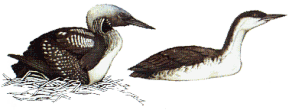|
|
| Main |
| Systematic List |
| Photo |
| Central Siberia |
| Guest book |
| Awards |
| SEARCH |
|---|
|
|
Gaviidae |
|---|
Black-throated Diver Gavia arctica (Linnaeus, 1758)
|
The Black-throated Diver, a Holarctic tundra and taiga species, is the commonest of the divers in Central Siberia, breeding on medium-sized and large lakes. The species is widespread, covering a range from the northern boundary of the typical tundra subzone (73°-74° N) south to the taiga lakes in the Sayan Mountains and the Minusinsk depression. The northernmost breeding record was located by members of our expedition in June 1991 near Pronchishcheva Lake in eastern Taimyr, 75°20' N by the expedition group of E. Syroechkovski Jr. The optimal part of its breeding range seems to lie in extreme northern taiga and in forest-tundra, since the breeding density decreases both to the south and to the north of this area. The species is rare but occurs regularly in typical northern and mid taiga. Further south, however, only single birds are encountered. The breeding density in the floodplain areas of the Yenisey forest-tundra is 2-7 birds/km2 and is 2.9-4.6 birds/km2 in the shrub tundra of eastern Taymyr (Chupin 1987). In Yenisey mid taiga, the Black-throated Diver occurs virtually on all large bodies of water with clear water but lacking a swift current and with low banks that do not hinder the long running starts the birds require for taking off. Thus, only the largest lakes in the Yenisey floodplain are inhabited (the Desyativerstnye Lakes, for example). Later in the breeding season, particularly during the algae bloom in eutrophic lakes, the divers regularly feed on the Yenisey, both along the river's edge and in deeper water. The factors preventing the birds from breeding directly on the river are the vulnerability of the banks to predators, disturbances by material transported by the river, and the muddy water, a result of active erosional processes. The largest breeding population is found on the Bakhta River, an eastern tributary of the Yenisey, where no less than 50-60 adults were seen late July on a 220 km stretch of the river. Some of the birds were still in family groups, but most of them were in flocks of about 13. In June and July a pair of Arctic Divers was found on every one of the watershed lakes under study (Olenye, Sosnovoye, Bolshoye and Maloye Lebyazhiy Lakes). The young birds are able to fly approximately by the middle of August. Soon thereafter, the birds depart. Autumn migration, which lasts from the beginning of the last third of August to nearly the end of September, concentrates the divers on the Yenisey; however, migrants are common over taiga areas as well, even many kilometers from the river.
|
[Back] |
|
|
|
|
Сайт разработан и поддерживается кафедрой прикладной экологии и ресурсоведения СФУ

